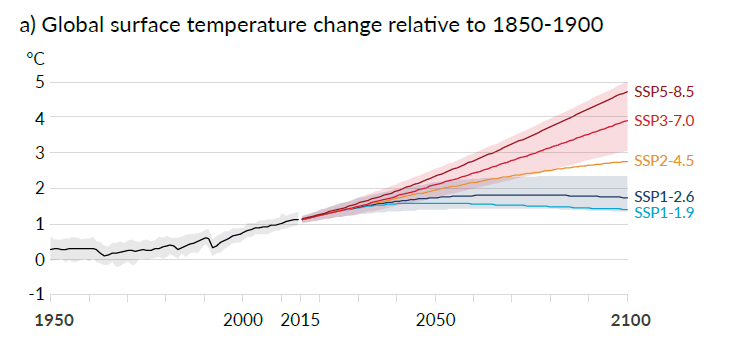The IPCC’s [1] latest report made the headlines a few weeks ago. The report confirmed that climate change is real, it presents adverse effects to us all and it is caused by human activity. For environmental professionals this is hardly news, but it is good to see the topic gaining even more media attention.
The key question is what to do about it. The IPCC will release later reports on this. For now, we have looked at some of the detail in the current report which reveals some surprising possible ways forward.
To look into the future, IPCC use a range of different scenarios to analyse what may happen in the future. Data from the scenarios is fed into various climate models and the outputs plotted to project what °C warming each scenario will lead to. The chart below is taken from the report and shows the impact of each of the scenarios. Each scenario has a label SSP1-1.9 to SSP5-8.5.

Only scenario SSP1-1.9 results in maintaining global temperatures to safe(ish) levels (i.e., less than 1.5°C rise in surface temperature). Here’s the headlines of what SS1-1.9 means [2]:
- Gradual, but pervasive, shift toward a sustainable path
- Inclusive development that respects perceived environmental boundaries
- Management of global commons slowly improves
- Education and Health investments accelerate the demographic transition, leading to a relatively low world population (interaction of low mortality rates, improved education- especially women, fertility)
- Economic growth shifts toward a broader emphasis on human wellbeing
- Consumption is oriented toward low material growth and lower resource and energy intensity.
What’s particularly interesting is the idea of transforming the world economic system for the benefit of human wellbeing instead of the current paradigm of maximising profit. We believe this has huge significance for the way we do things. Also, as a world, if we want to manage wellbeing, we are going to have to standardise our measurement of wellbeing. It may be worth starting this process now within our own organisations. First of all, measurement will provide data for designing and implementing improvement strategies. In the current Environmental, Social and Governance (ESG) investor climate, measuring wellbeing of staff and customers will also provide data for the “S” part of ESG investments.
Please be in touch if you’d like to discuss sustainability reporting and strategy development for your organisation.
[1] Intergovernmental Panel on Climate Change : https://www.ipcc.ch/report/ar6/wg1/
[2] The Shared Socioeconomic Pathways and their energy, land use, and greenhouse gas emissions implications: An overview: https://www.sciencedirect.com/science/article/pii/S0959378016300681
[3] Cover image credit: https://interactive-atlas.ipcc.ch/
